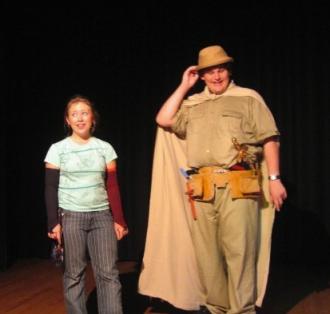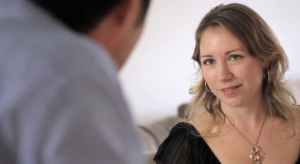There is no definitive answer to that question but it’s one that has come up a lot for me over the last few weeks. My answer is constantly evolving as I do more and work with or talk to more people, so I thought I would share some of my current thoughts on the subject and hopefully shed some light on acting as a craft and profession (or open up the discussion for people).
Acting has two sides to it, there is the literal process of “acting” and there is the business side. But let’s start with the former (I’ll explore the latter in part two). I think every actor has their own idea of what acting is, and probably everyone who has ever seen a movie, watched television, been to a play or studied acting has an opinion about what it involves.

Me and actor Nick James in stage play The Not So Supernatural (2005).
For me, I go back to a definition I’ve heard many times, particularly in the context of the Meisner Technique and Practical Aesthetics:
“Acting is living truthfully under imaginary circumstances”.
That means finding ways to believe and behave in an honest, authentic and organic way within the constraints of the work you are doing as an actor. It means every moment is different, so every take of a film, every night of a play and every rehearsal is as varied as life.
The approaches that actors take, however, can vary significantly. So you have a range of techniques and methods that actors will subscribe to and promote, as well as artists who explore everything and approach each role differently.
In my training with Meisner Melbourne, Clare Dea built on the idea of “living truthfully” through work on the self. We explored different parts of our selves to find emotional and personal states different to how we normally are. I remember when I started training with Clare I was very scared of feeling anger, bypassing it and going straight to tears. But after a few months I had found parts of my self that were open to feeling and expressing anger including, for example, a Bitch and a Protector.
Something really important that Clare drilled into me is that every emotion is important. Some of them don’t feel nice, and a lot of them we judge (which I have written about before), but as an actor it is vital that I am open to feeling every emotion and exploring them 100%.
This framework resonates with me but I’m also aware of other ways that you can “act truthfully” in any given moment. When I audited the Howard Fine Master Class in Melbourne last year, one of the things I took away from Howard Fine, David Coury and the actors working with them was that you have to be open to figuring out what works for a particular role. There’s not really one formula that will get you there every time.
I could, for example, find one role that hits close to the bone with me and brings up emotions and reactions organic because of the familiarity. Just recently, actually, I was working on a role that reminded me of the project I used to run for young people at risk of homelessness in Brisbane. I didn’t really have to do much work on my mind state to feel like the lines I said were truthful in the moment.
At other times actors get to explore things so alien to them that imagination (and a strong hit of empathy) may be the only way to find the truth. For example, I was once cast as a returned medic from the war, suffering post traumatic stress disorder and rebelling against a family that didn’t understand. I’ve never been to war. I’ve never had post traumatic stress disorder and my family is pretty cool, so I had to explore ways to find the truth of the character in myself (which I did find, and I think it is one of my strongest roles yet).
Finding Connection
When I was in my first year of uni I was working on a scene with a girl where we had to have a fight. I was lucky enough to have the very talented Andrea Moor (actor, director and teacher) as my teacher and in the very first rehearsal she showed the class she stopped me two lines in. I was standing down stage and my scene partner was sitting up stage.
“Ah, you’re doing something a lot of young actors do Amy. Why did you walk away from her?” she asked me. I said it was because I was angry with the other girl in this scene.
“Would you do that in real life?” Andrea went on to explain that so often young actors (and some very experienced ones too) will think it is better to internalise their character and emotions, to “work off themselves” in a sense. But, she said, it is more powerful to work with the other person in a scene. She got me to try the scene again, staying with the other girl and responding to her. It suddenly felt so much more real.
That one moment inspired me so much that I went on to do more training with Andrea, who has worked with the Atlantic Theatre Company to bring David Mamet and William H. Macy’s Practical Aesthetics technique to Australia.
At the same time as I was working with Andrea, I met a much more experienced actor in the same course as me who had trained in the Meisner Technique at the New York Playhouse. Kate taught me the basics of repetition and working with her reinforced how important it is to connect with the actors you are working with and to react truthfully to what they do, moment to moment.

Me and fellow Meisner Melbourne alumni Will Zhu in a scene together (2012).
The importance of connection has stayed with me since then, and it’s something I’ve been able to explore in theater productions, short films and particularly in training with Meisner Melbourne, Howard Fine Acting Studio Australia and, most recently, with Brett Cousins at Red Stitch Actors Theatre where I’m currently doing an acting intensive.
When I first spoke to Brett, one of the things he said to me was that “connecting with people” was something he loved about acting, and a lot of the work we have done so far has been around that idea of connection.
After the first session with him, while we were tidying up the lovely Red Stitch theatre, we got to talking about what acting is in relation to different techniques. Something I’d realised during the class was that physical activities (which are designed to get you “out of your head” and into the moment) can help create the action in a scene, but it is always the other people that take precedence. It’s really easy to get caught up in the “doing” of a scene and, indeed, some people describe acting as literally “doing” something. But whatever activity you are doing becomes secondary when you have a connection with someone; instead of doing something, you are being. And that, to me, is what acting is really about because by being truthfully in the moment, you can connect with not only the other actors, but also the audience.
NOTE: There is so much more I could say about the craft of acting, this is really just scraping the surface and a reflection of where I’m at right now, so I’m very interested to hear other perspectives and views on acting.
Filed under: Acting, Opinion Tagged: acting, Andrea Moor, Brett Cousins, Clare Dea, David Coury, Howard Fine, Howard Fine Acting Studio Australia, Meisner, Meisner Melbourne, Practical Aesthetics, what is acting

